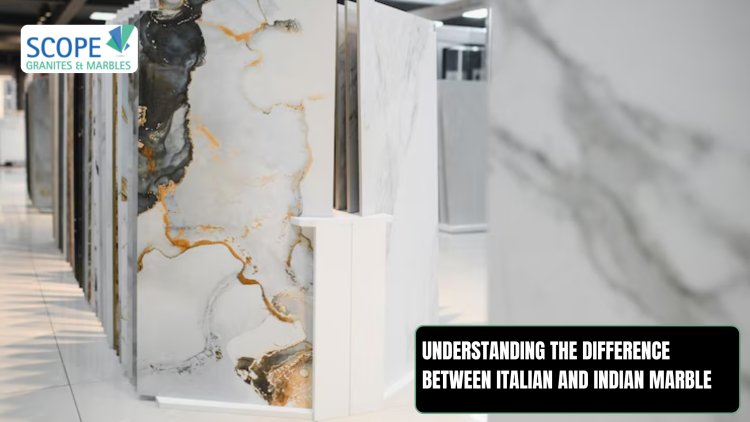Understanding the difference between Italian and Indian marble
Marble is the material of choice when it comes to premium flooring and luxurious interiors. The quality of marble varies from one manufacturer to another.
Share this Post to earn Money ( Upto ₹100 per 1000 Views )

Introduction:
Marble is the material of choice when it comes to premium flooring and luxurious interiors. The quality of marble varies from one manufacturer to another. Italian marble and Indian marble are two of the most popular varieties, each possessing its own unique charm, strength, and style. The difference between high-end villas and modern commercial spaces can assist you in making a better decision, regardless of whether you are designing a high-end villa or a modern commercial space. Our guide to marble types will explain what sets them apart in terms of color, durability, price, and maintenance, so you can pick what's right for your dream project.
Origin and Global Appeal:
Italian marble, as the name suggests, is imported from the quarries of Italy, particularly from regions like Carrara and Verona. Known for its soft, silky texture and high-gloss finish, Italian marble is globally regarded as a symbol of luxury. Indian marble, on the other hand, is quarried across various parts of India such as Rajasthan, Gujarat, and Madhya Pradesh. While Indian marble has been used for centuries including in iconic structures like the Taj Mahal it offers a more traditional appeal at a more affordable price point.
Color and Veining Patterns:
One of the most visually distinct differences lies in the color palette and veining. Italian marble is typically available in light, creamy tones with elegant, flowing veins that give it a classic and timeless look. Famous varieties include Carrara White, Statuario, and Calacatta. Indian marble offers a broader color range from deep green (like Verde Guatemala) to pure white (Makrana White), golden hues, and even pink. The patterns in Indian marble are often more dramatic, making it ideal for bold and vibrant designs.
Strength and Durability:
Italian marble is softer and more porous than Indian marble. This means it requires extra care and sealing to prevent stains and scratches. While its softness adds to its aesthetic appeal and ease of cutting, it may not be ideal for high-traffic areas without regular maintenance. Indian marble, by contrast, is denser and more durable, making it suitable for long-term use in both residential and commercial projects. If you’re looking for strength with beauty, Indian marble stands strong literally and figuratively.
Finish and Aesthetic Appeal:
Italian marble is known for its ultra-smooth finish and rich, luminous polish. It gives interiors a high-end, sophisticated look, often seen in five-star hotels, upscale malls, and luxury homes. Indian marble, while equally beautiful, has a more earthy and grounded appeal. It can be polished to a high sheen, but its natural grainy texture is often preferred for rustic, heritage-inspired, or contemporary Indian interiors.
Cost Comparison:
Cost is a major differentiator. Italian marble is more expensive, not just because of the import duties but also due to its premium quality and brand value. Prices can range between ₹350 to ₹700 per sq. ft. or even higher depending on the type. Indian marble is more budget-friendly, usually ranging from ₹60 to ₹250 per sq. ft. For large-scale projects, Indian marble is often the go-to option to achieve elegance without overshooting the budget.
Maintenance Requirements:
Italian marble demands careful upkeep. It is more prone to staining, scratching, and weathering. Regular sealing, cleaning with pH-neutral products, and prompt spill management are essential to retain its beauty. Indian marble is relatively low-maintenance. It resists moisture and staining better, and basic cleaning can keep it shining for years. For homeowners who prefer style with convenience, Indian marble may be the smarter choice.
Suitability for Different Spaces:
Italian marble is ideal for indoor applications like countertops, wall cladding, and decorative flooring in areas with minimal wear and tear. It adds a luxurious vibe to bedrooms, living areas, and bathrooms. Indian marble, being sturdier, is well-suited for both interiors and exteriors. It can be used in courtyards, heavy-use kitchens, commercial lobbies, and even outdoor garden paths.
Sustainability and Local Sourcing:
Choosing Indian marble supports local industries and reduces the carbon footprint associated with international shipping. It’s a sustainable option for eco-conscious builders and designers. Italian marble, while beautiful, has a larger environmental impact due to transportation and energy-intensive processing. If going green is part of your design philosophy, Indian marble makes both environmental and economic sense.
Luxury vs. Legacy:
Italian marble is often equated with ultra-modern luxury sleek, elite, and glamorous. Indian marble carries a legacy of heritage and royal architecture. From palaces to temples, it’s a part of India’s cultural soul. Your choice depends on the story you want your space to tell: global opulence or timeless tradition.
Conclusion:
A decision between Italian marble and Indian marble will ultimately depend on your priorities - budget, aesthetics, durability, and maintenance. Those looking for an elegant, international look who are not concerned about the price tag should consider Italian marble. Indian marble offers the greatest variety, the greatest strength, and a price that fits most budgets. There is no wrong choice both options are characterized by natural beauty and an undeniable charm. Choose the option that best reflects your style, purpose, and personality.

















